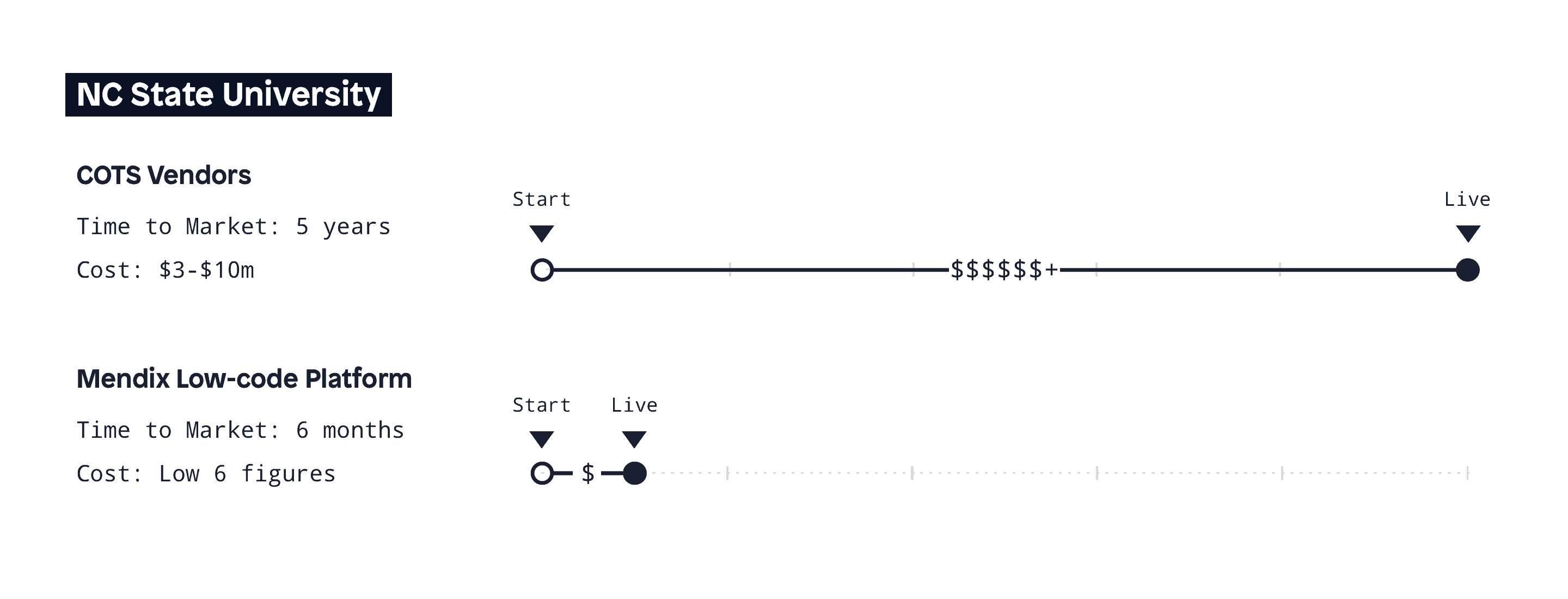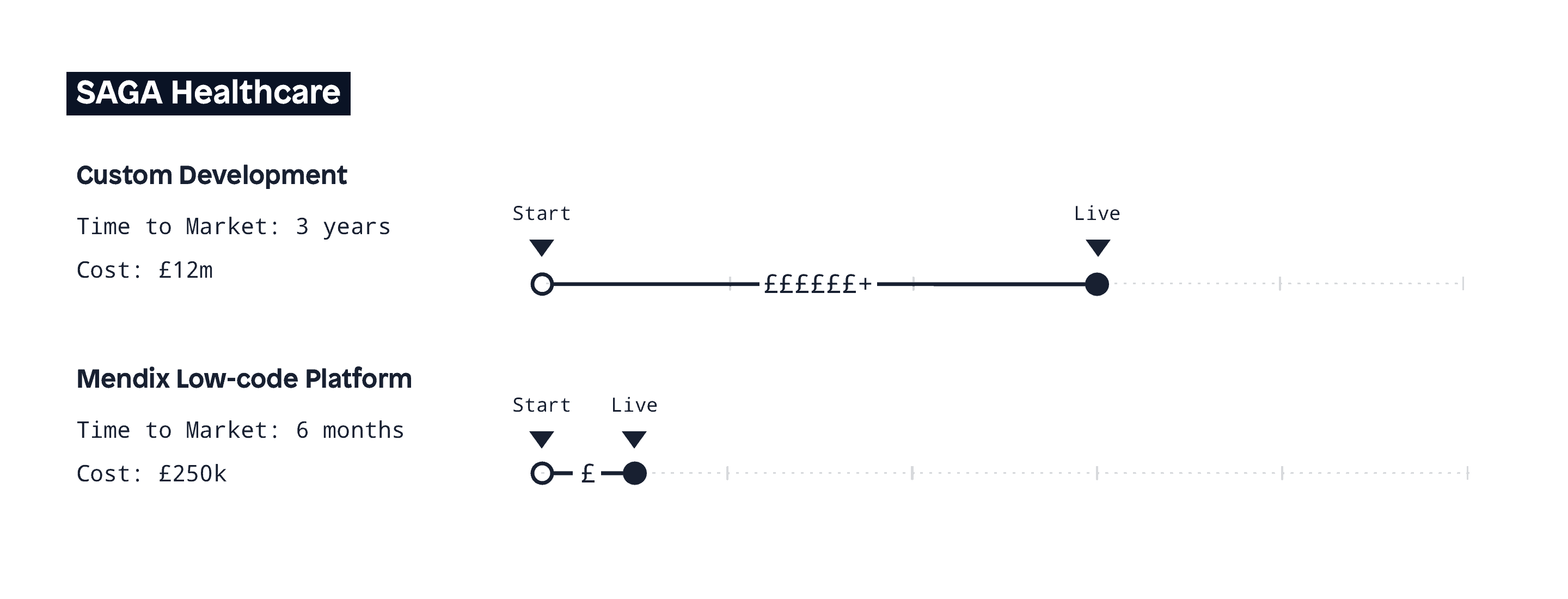When to Build vs. Buy Software: The Pros & Cons

To build, or not to build, that is the question. While the Bard was never faced with the dilemma of whether to build vs. buy software, the modern enterprise is surely plagued by the decision.
With technology evolving, the build vs. buy software decision is not so cut and dried anymore. The way we build custom software has changed. And with these new technologies, organizations now realize higher ROI and faster time-to-market.
Read on for a build vs. buy analysis and stories of companies that made the decision.
Pros of buying COTS
When considering a build vs. buy software decision, companies have typically looked toward buying commercial-off-the-shelf (COTS) software over the past 20-plus years.
It makes sense, too. COTS software offers benefits like:
- It’s readily available since the product is already built
- It offers high value for solving a simple solution
- There is a lower initial investment
Historically, building custom software has been expensive and time-consuming — 53% of projects cost 189% of the original estimate and organizations cancel 31% of build projects. If you’re just looking for a basic, simple solution to a widely occurring problem, COTS products offer a better value up front.
Cons of buying COTS
Even the best solutions have their downsides. COTS’ biggest strength is also its greatest weakness: It’s designed for the masses. COTS is intended to be a one-size-fits-all solution to common problems, like the need for an ERP system or a simple claims processing tool.
Because of this, you have to look closely at the cons of buying COTS:
- There are always potential delays in software updates
- Extensive customizations are required for IT integration
- It’s challenging, if not impossible, to adapt it to your business’ changing needs
When to buy COTS
When choosing the best software solution, buying may be best if:
You don’t need any customization
Buying a COTS solution may be the best choice if you need a fast, straightforward product. However, it may only address a short-term business solution. As the needs of the business grow and change, you may need something that can evolve along with it.
You need a predictable cost
As we’ve previously mentioned, customized solutions can quickly balloon in costs. Buying a software solution ensures that you know the cost upfront, which is a huge benefit if you have a strict budget you need to stick to.
You need a software solution fast
Building a custom solution can take up to nine months — and that’s if everything goes smoothly! But if you need a fix yesterday, buying an off-the-shelf software may be a good fit.
Pros of building custom software
Professional developers may find the promise of building programs tempting. While buying COTS may be faster, it also can feel limiting. If your company has specific needs and requirements, the best option is to build.
The pros of building software include:
- Creating highly customized software to solve business problems
- Integrating the software into your IT infrastructure easily
- Updating software as the business changes or as developers receive feedback
Cons of building
You may have noticed that developers are a hot commodity in recent years. It’s increasingly difficult to fill software developer roles, with these jobs taking 80 days to fill (compared to just 42 days for non-developer roles). That’s just one of the cons of choosing to build a software solution.
Other cons include:
- Developers brought in for their skills may need additional training to learn about the company’s business needs
- A larger investment of time and money
- The application development lifecycle has a longer timeline
When to build custom software
Choosing to build a software solution may be best if:
You need a combination of different functions and capabilities
When companies need a long list of different capabilities, it may need to buy several off-the-shelf solutions and cobble them together. Building software gives companies the opportunity to create a custom solution that addresses all of their business needs.
You have the resources
If you have a bigger budget, you may be able to build exactly what you’re looking for. Additionally, if you already have the existing resources – like software developers – available, building may be the solution you need.
You want a solution that can grow with your business
There is usually a larger up-front investment when building a software solution with traditional development. However, building custom software allows you to make modifications as your company grows and changes.
Related Reading: COTS Software vs. Custom Low-Code Development
A third option: Low-code
Using traditional coding methods to build a complex application might sound intimidating (and expensive). Companies don’t just have to choose between build vs. buy. There’s a third choice: low-code application development.
Low-code has changed the way we develop software applications. It comes with its own pros and cons. The pros include:
- Increased collaboration between teams, especially those without coding experience
- Accelerated development lifecycle
- More consistent feedback especially when utilizing Agile workflows
- Increased ability to take full control of the application development lifecycle
- Reduced long-term costs
Build vs. buy: How companies made the decision
Head-of-the-class ROI
NC State University chose to build vs. buy. Units across the NCSU campus had developed solutions for non-credit registration management using SharePoint, Access, sticky notes, and spreadsheets. The data disparity created inefficiencies, so the university sought a new way to manage their non-credit enrollment system. Time, budget, and other resource constraints made building a custom Java application in-house unfeasible, so NCSU opted to release an RFP. The quotes they received from COTS vendors were staggeringly high: $3-10M over five years.
Modern development technologies and practices have broken down many of the barriers that traditional development built up over the years, which slowed projects and killed budgets. For example, DevOps practices have dissolved the silos between R&D and Ops to allow developers to launch software faster and with better quality.
Another technology that’s redefining what it means to build is low-code, which Gwen Hazlehurst, Assistant Vice-Chancellor, Enterprise Application Services at NCSU, used to enable a team of student developers to build a solution in house, despite having very little coding experience.
“We charged our student interns with the task of researching other options,” she says. “That’s when we started to become aware of low-code platforms as an alternative to rapidly develop and deliver code.”
Using low-code, a team of student interns built an MVP of the system called REPORTER, in just over two months. Three months later, they launched the full system. The total cost in money and time of REPORTER: low six-figures and six months to release.

A healthy dose of savings
Saga Healthcare is the UK’s leading elder advocate. With low-code development, Saga entered a new market and extended the commitment and services they offered their customers.
Saga was looking to develop a new system to provide home health care services to seniors. In the build vs. buy software paradigm, Saga started out looking at outsourcing development for a custom application. After being quoted by a vendor for £12M with a three-year build time, Saga looked for other options. Aside from the high costs and lengthy development time, Saga also needed a way to quickly make changes to their application to address business and market demands. They weren’t going to get that with an external solution.
CEO Lance Batchelor inspired the IT team to use unconventional thinking to consider alternatives. Following this directive, Saga IT decided to develop with the Mendix low-code platform. With low-code, the IT team built a care-at-home scheduling system, SACHA, in just six months for less than £250k — a cost savings of 97.9%.

Read more on build vs. buy
So, build or buy? Before now, you had two options: Buy a COTS product for swiftness but lose agility, or build your own software to maintain control and agility but risk a costly or failed project. But the latter is not the case anymore.
Low-code development and other technologies are changing how we build applications. Learn how by clicking the banner below.
This post has been updated. It was originally published on December 17, 2019.
